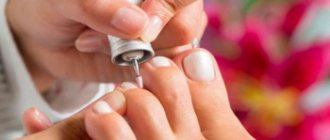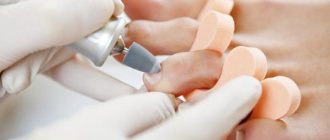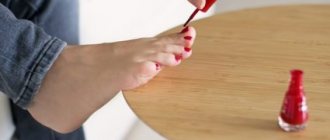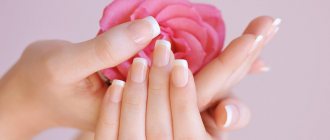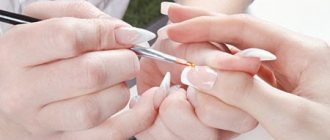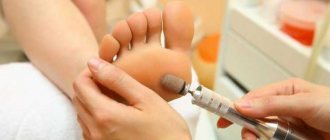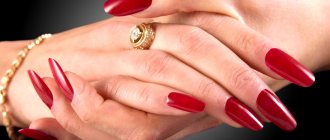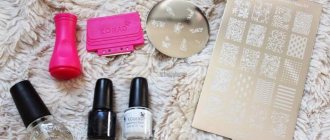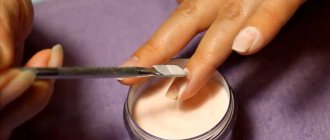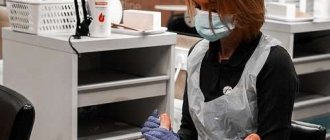First you need to decide which pedicure device is best to purchase. There are professional and household pedicure devices. The former are distinguished by increased power, many functions and a wide range of cutters. Working with them requires serious training, because in inexperienced hands, a device operating at high speeds can cause injury. Therefore, a household appliance is sufficient for the home.
Household pedicure devices are offered in a wide range. Cheap devices with very low power will bring more trouble than good results. It is not necessary to overpay; it is better to buy a device in the middle price segment, which will have good technical characteristics sufficient for high-quality foot treatment.
What characteristics should you use to choose a household pedicure device:
- Power . The higher the power of the pedicure device, the faster and better the foot treatment procedure will be carried out.
- Vibration . If vibration is strong, the procedure will quickly cause hand fatigue. It may be difficult to work with small nozzles.
- Lightweight and ergonomic device . Vibration also affects the comfort of working with the device.
- Universal functions . It is not necessary to take this characteristic into account, since many functions are often not used. Therefore, before paying money for a particular function, you should carefully read them.
- Guarantees . You should choose a device from well-known manufacturers, since it is purchased for many years, although it is not cheap.
Before you do a hardware pedicure at home yourself, you need to carefully prepare informationally.
To do this, it is advisable to visit a salon where you can see all the intricacies of a professional’s work.
We recommend: Footrest for pedicure: luxury or necessity
Be sure to read the instructions for the device and how to use various attachments for hardware pedicure.
You need to study which cutter is intended for which operation and what features there are when working with each of them.
Regular pedicure: what is the difference from hardware pedicure
To determine the benefits of hardware pedicure for beginners, you need to understand how it differs from other types of foot care. Let's look at the main types of foot care.
Classic pedicure
With this treatment, the feet are soaked in water, dead skin cells are rubbed off with a pumice stone, the cuticles are trimmed with scissors and nippers, the nails are filed and varnished.
European pedicure
The feet do not need to be softened with water and there is no need to use scissors. This is where special products for removing corns come in handy.
Dry pedicure
This option involves treating the skin of the feet “dry”. All unnecessary growths are cut off without soaking or softening with nail files.
Hardware pedicure
If the usual types of pedicure require the use of foot baths and files, then for hardware care you only need a good device. The foot and nails are processed using cutter attachments. They are available in various shapes to make it possible to tidy up all problem areas of the skin.
In order to correctly carry out the procedure yourself, we will try to tell you everything with detailed explanations.
What is a hardware pedicure
Treatment of the skin of the feet and nails with the device involves grinding the keratinized areas using various cutters. The master decides which polishing cutters to use individually, based on the characteristics of the feet and nails. Before treatment, feet are not soaked in water. Professional pedicure cosmetics are applied to them.
Combined pedicure
An option in which two types of pedicure are used - classic and hardware. A foot pedicure is done using a machine, and nails and cuticles are tidied up with the usual scissors and files.
Medical hardware pedicure
If a person has problem feet and suffers from corns and ingrown nails, fungal diseases, hyperkeratosis, then a regular pedicure will not suit him. He needs professional medical hardware care.
This treatment of the feet can only be carried out by a podiatrist. He will use special medicines.
What are the features and differences of the procedure
If you have ever been to Europe and visited at least one, even the simplest, beauty salon, you know that you will never see baths for steaming your feet, as well as razors, scissors and tweezers. They prohibit this for hygienic reasons. Only hardware manicure and pedicure are performed using softening gels, creams, oils and a device with attachments - cutters.
The essence of the procedure is to apply a special product to the skin of the feet, which may contain natural acids, to soften the keratinized areas of the skin. After this, the master, using attachments of different sizes and textures, treats the feet, cuticles and nails, adjusting the rotation speed and pressure force of the device. Thus, by changing the cutters, speed and sliding force, you can remove calluses and corns, rough skin around the nails, grind overgrown nail plates, treat cracks and even correct the shape of extended acrylic or gel nails. At the end of the procedure, a nourishing cream is applied to the skin, and at the client’s request, the nails are varnished.
Some young ladies are distrustful of hardware pedicure, believing that it is possible to remove dead skin from the heels efficiently and deeply only with a razor and pumice stone, and cut the cuticle with scissors. It's not like that at all! In practice, it has been proven that after a razor, the skin on the heels grows again in almost a week, especially in the summer, when clogs and sandals are worn. After treatment with cutters, you can forget about calluses, cracks and corns for two to three weeks.
Which pedicure is better: hardware or classic?
To determine which pedicure is better: hardware or classic, let’s look at their main differences.
- In order to do classic foot care, you need to use water, and in the hardware version, only creams are used to treat calluses, corns and cracks. This speeds up the process a little and eliminates the possibility of infection.
- Soaking the feet in warm water, which is mandatory for the classical approach, is not recommended for people with thrombosis.
- Getting your feet in order using special equipment is absolutely painless, but a regular pedicure can lead to unpleasant sensations.
- Trimming pedicure means working with nail scissors and clippers, and this often leads to cuts. Infection can enter the body through wounds.
- A special device will help achieve smoother foot skin and better nail shape than manual treatment.
The advantages of a pedicure done with a device indicate that in many cases it is worth purchasing a device and caring for your feet yourself. The price of the device can be quite affordable.
Hardware pedicure at home step by step
If you are lucky enough to get hold of a milling machine and decide to experiment, here are detailed instructions on how to do a hardware pedicure step by step.
- First, prepare your workplace: you need good lighting, free access to a 220 W power supply, a table to lay out the cutters or install a milling machine, a disinfectant solution, a softening gel and other attributes for a hardware pedicure, a footrest or stool, cellophane that should be lay it on the floor - this will make it easier to collect pieces of removed skin and nails later.
- Uniform required: gown, head cap, gloves and face mask. Even if you are doing the procedure for yourself, a mask will not hurt, since when the milling machine works intensively, pieces of skin fly in different directions and can get into your face.
- An antiseptic is applied to the client's feet (or your own) and hands. The remains are blotted dry with a paper towel. Then the feet need to be evenly covered with gel to soften the keratinized layers of the skin. Leave for 10 minutes.
Advice: some girls, in order to enhance the effect of the procedure, first steam their legs in a basin of water, and then do a hardware pedicure over it. This is fundamentally wrong and dangerous! Do not forget that the device operates from the mains, and contact with water can end very badly!
- If necessary, the length of the nails is removed - this can be done later using cutters. After this, you can proceed directly to treating the foot. Use a 60/60 coarse scrubbing attachment first at 10,000 to 20,000 rpm. Then sand the feet, changing the nozzle to a fine-grained one - 100/100.
- Now move on to your toes. To do this, you need a cone-shaped coarse-grained and fine-grained cutter. First, work with coarse grit at a speed of 5-10 thousand rpm, then sand the leather with fine grit.
- The next stage is cuticle removal. Apply a special gel or oil to the cuticle, treat the nail fold with the same fine-grained nozzle. To remove cuticles, use a ball-shaped diamond cutter. The speed should be no more than 6 thousand revolutions per minute. There is no need to try to push back the cuticle with the nozzle - our task is to even it out and make it smooth.
- After completing the procedure, the remnants of the softening gel and epidermis are removed, you can rinse your feet in warm water, wipe dry and apply a nourishing or deodorizing cream. Cuticle oil is applied to the nails and cuticles, after which a felt cap is put on and the nails are buffed to a shine. Varnish can be applied if desired.
For information: gels for softening the skin of the foot are called keratolytics; they can be purchased at professional cosmetics and equipment stores. Since keratolytics contain acids, they must be handled with gloves and applied with a brush. The natural acids that the product contains not only help soften and more easily remove rough skin and corns, but also saturate the cells with antioxidants, promoting their accelerated regeneration.
That's all about how to properly do a hardware pedicure at home with your own hands. In conclusion, we can add: if you have problematic feet with fungus, ingrown toenails or deep cracks, trust the care of them to professionals, performing only daily preventive and supportive procedures at home.
How to do a hardware pedicure at home with your own hands, features of implementation
After purchasing a pedicure device, you can start treating your feet. The procedure is more comfortable and painless, but not quick. For example, a pedicure treatment of feet with cosmetics to soften the skin will take about an hour.
The first procedures are best performed at a lower speed. The nozzles should be positioned at an angle of 35 degrees to the surface of the body. All movements during work must be done from the center to the edges, opposite to the direction of rotation of the cutter. Do not keep the working attachment on one place of the skin or nail for a long time.
How to do a hardware pedicure
The peculiarity of foot treatment using the device is an integrated approach. You just need to watch the video lessons (presented in our article), learn how to choose the appropriate attachments for different areas of the foot and follow the recommendations of experts step by step.
What is needed for the procedure
- Apparatus for home pedicure with a set of attachments. Only two or three attachments are sold with the machine, so you will have to buy the missing ones to get the desired treatment.
- A product for softening dead skin.
- Antiseptic gel.
- Moisturizing foot lotion or medicinal ointment with the desired effect.
Technique for performing hardware pedicure
The procedure for hardware foot treatment can be carried out approximately once every two weeks. Men get a professional pedicure once a month.
Step-by-step instructions for hardware pedicure.
- Apply the remover to your feet. The leg must be properly prepared for the procedure.
- When selecting the necessary cutters, grind all areas of the foot in order. First, the heels are polished with coarse cutters, then the rest of the foot is processed, paying attention to the calluses. Separately, clean the stratum corneum from your thumb. Afterwards you need to treat the cuticle.
- Each nail must be put in order: given the correct shape and polished. Toenails are not given an oval shape so that they do not grow into the skin.
- Now you need to cover your nails with decorative or hygienic varnish.
- And the last stage is applying a moisturizing or medicated foot cream.
Foot pedicure
The skin of the foot requires special attention. After softening with the product, the feet should be blotted with a napkin. Then the skin of this area is sanded with a coarse-grain cutter to remove calluses and growths. Polishing should be done using a fine abrasive attachment. With a similar cutter you can process the areas between the fingers and the rollers on the sides.
Advantages
If we talk more specifically about the advantages of a SMART pedicure, the main advantage is the absence of unpleasant sensations. This feature of SMART pedicure is due to the fact that the disc used hardly heats up and does not tear the skin.
The safety of this procedure is also an advantage. The disc base is always thoroughly disinfected, and consumables are changed after each client.
This approach ensures absolute sterility. The safety of the procedure is confirmed by the fact that there is no chemical effect on the skin.
Another tangible plus is the durability of the result. After the procedure, your feet will remain smooth for at least three weeks. But in most cases, you can enjoy the well-groomed and beautiful feet for much longer (on average from one and a half to two months).
Rules for choosing a pedicure machine
To do a proper hardware pedicure at home, you need to purchase a device with suitable characteristics.
- No need to buy a bulky model. There are compact devices on the market that are convenient not only to use locally, but also to take on trips.
- Pay attention to the weight of the handle. It should be no more than 200 grams, otherwise your hand will get tired quickly.
- The shape of the handle should be comfortable to make the procedure easy.
- Please note that there is a built-in vacuum cleaner. It will help get rid of sawdust.
- A home appliance should not have a cord that is too long.
- While learning is happening, it is best to have equipment with a foot pedal to control the speed.
- The power of the pedicure device must be at least 35 watts. Manicures can be done using a model with less power, but it will be difficult to do foot treatments.
Before purchasing equipment for home nail treatment, you should read reviews from those who already use such devices.
Which cutters to choose
Milling cutters vary in degree of abrasiveness. Nozzles with coarse grains are used for grinding keratinized tissue. Fine abrasive attachments perfectly polish the skin.
The cutters also differ in size.
Which attachments are suitable for what?
Large attachments are used for the feet, and small ones for the toes and the area between them.
The material from which the cutters are made also matters:
- Diamond tips are good for rough skin.
- Ceramic cutters are used to remove cracks.
- Silicon carbide cutters are excellent for grinding heavily keratinized skin.
- Silicone nozzles are needed for polishing nails.
An independent hardware pedicure is an excellent solution for those who are not satisfied with the high cost of services in the salon. In addition, doing a pedicure at home is convenient and pleasant.
How professionals do a classic pedicure
In the master’s office, he has a full range of tools with which he will treat your feet, taking into account the type of skin and the condition of the nail plates:
- Any type will benefit from a hardware pedicure, which requires special cutters and equipment. This type will help to quickly make the legs smooth and soft, the main thing is to choose the right rigidity of the cutter;
- If your feet are very delicate, it is better to refuse the classic one in the salon, giving preference to the European one. The essence of European pedicure is no cutting tools. Wooden or orange sticks are used to treat the cuticles, and the feet are cleaned with brushes;
- For rough and normal skin, a classic pedicure with scissors, files and nippers is suitable;
- Those who want to improve their skin or cure their feet from existing diseases should resort to a medical pedicure. During treatment, the master will use special products that penetrate deep into the skin and have a healing effect.
A professional pedicurist always carries out the procedure according to a strict algorithm:
- Treats the client's feet with a disinfectant. After it dries, it determines the client’s skin type in order to choose the right care and not injure the skin;
- Pushes back the cuticle with an orange stick and applies remover to the foot for 2-4 minutes. At this time, the master prepares the steam bath by adding salt to the water;
- While the client's feet are steamed for 15 minutes, the master prepares tools suitable for the type of feet of the visitor;
- Now you can start cleaning your heels using a special wet brush. After the rough layer is removed, the master polishes the foot with a softer grater;
- After cleaning, the master trims the cuticle and corners of the nails, which may cause discomfort to the client, and evens out the edges with a nail file;
- The next stage of cleansing is exfoliating the remnants of the stratum corneum using a special scrub. After washing off the scrub, the master shapes the nails and treats them with nail files;
- The master should secure the result with cuticle oil and foot cream, which must be rubbed in with massage movements;
- The last thing to do is apply a decorative coating.
Milling speed
In addition to material, abrasiveness and shape, consider the operating speed of the machine for each individual cutter. The product descriptions on our website indicate the operating mode of the router recommended by the manufacturer, but you will need to adjust the rotation speed of the attachment depending on:
- surface type: the rougher the skin or thicker the nail, the higher the speed should be;
- skin sensitivity: the silicone cutter heats up during operation, reduce the speed of the cutter to eliminate discomfort during the procedure;
- processing purposes: you need to remove gel polish with a ceramic cutter at low speeds - 5-6 thousand / min, so as not to “grab off too much”;
- cutter material: steel attachments are designed for rough processing of complex surfaces - cracks, calluses, hyperkeratosis; milling cutter speeds can reach 24 thousand/min;
- amount of dust: the sand cutter generates dust during operation; To prevent it from clogging, reduce the speed of the router to 10 thousand/min.
List: What you need for a home pedicure
Nail service professionals have in their arsenal a huge number of different tools: nippers, tweezers, stands, various files and scissors, sharpened in different ways. At home you can do without most of the gadgets, but you will need more than just scissors. What do you need to have in your kit for competent and high-quality foot care at home?
Foot massage bath
An indispensable tool for foot care. The bath will help steam your feet, making cuticles and calluses more pliable for removal, and at the same time allow you to relax and unwind. You can buy a steam bath at any salon that has accessories for manicure and pedicure.
If you do not want to purchase a massage bath, you can use a regular container or basin, filling it with warm soapy water. The effect will be the same, only without the additional functions that baths have. Prepare a towel to remove excess water from your feet after steaming.
Nail Polishing Machine
This tool with various attachments, also called cutters, can replace files, nippers and tweezers. With its help, the cuticle is removed, the edges of the nail are smoothed, the surface of the nail plate is polished and rough skin is removed.
Such a device can be found in different price categories, and, of course, the professional version of the tool will not be cheap. However, you can buy a semi-professional set and gain experience in finger processing.
This machine will help you do a hardware pedicure or manicure at home. To do this, you do not need a whole set of attachments, like from a specialist in a salon; buy only those cutters whose rigidity suits your skin type.
Only a Tornadel hood will save you from pedicure dust during polishing.
Choose a hood that suits you 100%
To catalog
Scraper
A scraper is an excellent tool for dealing with rough, dead skin on the feet. The device is a razor in a convenient attachment to make the grooming process safer. But even in this case, you need to use the scraper very carefully to avoid cuts.
Use this tool only when the roughest file does not help remove the stratum corneum from the heel.
Pusher
It is best to have a double-sided pusher: with a spatula at one end, move the cuticle, and with the tip at the other end, remove it from the nail plate. Usually pushers are made of metal, but there are also regular wooden sticks that are safer for the nail, however, metal ones are considered more effective.
Nippers/tweezers
Nippers with pointed ends of a triangular shape allow you to efficiently cut off hangnails and cuticles due to their tight fit to the skin. You can even trim your nails with straight-shaped tweezers.
Files
For proper nail care, it is better to purchase files with different types of coating: from the coarsest with 100 grit to treat the toughest areas of the foot, to soft ones with abrasiveness up to 1500 grit for delicate care of the skin of the feet.
Scissors
In most cases, they can be replaced with the same nippers/tweezers, but it is useful to have pedicure or manicure scissors with rounded ends in your arsenal to efficiently trim the thin and flaky free edge of the nail.
This is a minimal set of tools that will help you make your feet well-groomed and beautiful without visiting a specialized salon. Some of the devices are interchangeable, which allows you to save a little but still achieve the desired result. But still, if you want to become a professional pedicurist or have a good reputation, then you should pay attention to the health of your clients and choose a pedicure hood for yourself.
For those who want to delve even deeper into the issue of foot care, we are talking about products that will carefully prepare the feet for further processing:
- liquid for removing corns;
- cuticle softening liquid;
- foot scrub;
- softening foot cream after care.
SPA pedicure
This procedure is not only for care, but also for relaxation. When performing a SPA pedicure, no cutting objects are used, there are no injuries or discomfort. To cleanse and moisturize the skin, peelings, masks, serums, creams, and aroma oils are used. SPA pedicure is soft and gentle, it gives a relaxing effect and puts you in a positive mood.
But for severe foot problems, it is better to combine this procedure with other types of pedicure.
Choosing the best pedicure option is, of course, individual. But still, in order to walk with an easy gait, it is worth choosing modern methods that have already proven their effectiveness.
Features of smart pedicure
The foot is treated using smart technology. To do this, the master needs a grinding disc. This technology differs from the classical one in that the specialist processes the feet faster due to the fact that the area of the nozzle itself is larger. Typically, a nozzle is inserted into a manicure machine, and an abrasive wheel is attached to it.
The nozzle and replacement abrasives are produced by the same company - Smart. What smart discs for pedicure are there?
- XL is the largest diameter, 30 mm;
- L – slightly less than the largest, 25 mm;
- M – average diameter, 20 mm;
- S – small, 15 mm;
- Baby – the smallest, 10 mm.
The master selects a specific disc diameter based on the size of the client’s foot. It is worth noting that if the area on the heel is being treated, then you should take a larger nozzle, and if between the toes, then the smaller the better.
There are two types of discs;
- glossy;
- matte.
There is not much difference in what surface the smart pedicure attachment has. The quality of work will not suffer from this. It's all about aesthetics: some artists and clients prefer it when the disc plays with metallic reflections.
Each removable file has its own abrasive:
- 320 grit discs are used for polishing;
- The master polishes the feet with 240 grit discs;
- 180 grit are discs for not too rough leather;
- if the skin of the feet is rough, 100 grit discs are needed;
- 80 grit discs are the best solution for extremely rough leather.
Each abrasive is divided into a specific class:
- Standard black - Standard: usually these abrasive files are packaged in transparent bags. To remove the protective film, use tweezers to pick up the edge. It's not always easy, you have to work hard.
- White – Premium: available in boxes. There is perforation on the protective film. This is necessary for quick removal of the abrasive. You should press on the edge of the abrasive, then the edges will come off in the place of special perforation. This removes the film and then removes the abrasive.
These abrasives are made of silicon carbide and coated with a thin layer of silicone. Abrasives are made in the same sizes as the disk attachments.
Combined pedicure
This method combines the advantages of hardware and trimming techniques. In a combined pedicure, the feet are steamed in water, then treated with a device, removing corns, cracks and rough skin. During a combined pedicure, the cuticle is removed by trimming.
A combined pedicure, like any other procedure, requires the professionalism of a specialist. An experienced pedicurist should know that sanding wet skin is not only ineffective, but also dangerous - it can lead to cuts and injuries.
How are smart discs different from abrasive caps?
- As described above, the diameter of the disc is larger than the diameter of the cap, for this simple reason the disc is able to cover a sufficient surface of the foot. Processing is faster.
- During operation, the disk is not able to heat up. The client will not feel any burning sensation. The cap may burn unpleasantly in some places.
- Due to their composition, disc attachments do not injure the epidermis as a whole and are not capable of leaving the so-called “tearing marks” that occur after a cap.
- The disc is suitable for working with soft skin of the feet. The cap in this case will not be appropriate due to the risk of injury.
- Using the nozzle, you can not only get rid of dead skin, you can also polish your heels and other parts of your feet. Polishing allows you to completely clean the feet from any remaining roughness and due to it, skin will slowly grow in certain places. It is impossible to do this with caps.
- Disc abrasives are cheaper than caps. The price for one cap varies from forty rubles; abrasive can be found for three to six rubles. Good savings.
Nail work
| Processing type | Cutter material | Form | Diameter (mm) | Abrasiveness |
| Removing gel polish, acrylic layer | Ceramic | Cone | 6 | Medium/Coarse |
| Shaping the free edge of the nail | Diamond | Needle | 1,8 | Rough |
| Removing part of the nail plate | Diamond | Straight cylinder | 3 | Soft |
| Nail length correction | Sintered Diamond | Reverse cone | 2,5 | Rough |
| Treatment of hyperkeratosis (thickened nails) | Carbide | Straight cylinder | 5,5 | Medium (single cut) |
| Working with extended nails (acrylic) | Steel | Cone | 1,6 | — |
| Pterygium removal | Diamond | Rounded cone | 2,1 | Average |
| Cleaning the area under the nail | Carbide | Pointed cylinder | 1,6 | Double cross |
| Cuticle lifting and removal | Ceramic | Cuticle-clean | 1,6 | Average |
| Nail alignment | Silicone | Cone | 10 | Average |
| Delicate grinding | Corundum | Cone | 6 | Average |
| Final treatment (including diabetic foot) | Silicone | Cone | 13 | Thin |
